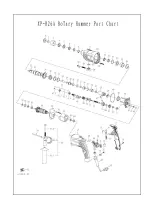
{
Do not attempt to drill anchor holes or holes in concrete with the machine set in the rotation only
function.
{
Do not attempt to use the rotary hammer in the rotation and hammering function with the drill chuck
and drill chuck shank attached. This would seriously shorten the service life of every component of the
machine.
4. When driving machine screws (Fig.9)
First, insert the bit into the socket in the end of drill chuck shank.
Next, mount drill chuck shank on the main unit using procedures described in 4(1), (2), (3), put the tip
of the bit in the slots in the head of the screw, grasp the main unit and tighten the screw.
CAUTION:
{
Exercise care not to excessively prolong driving time, otherwise, the screws may be damaged by
excessive force.
{
Apply the rotary hammer perpendicularly to the screw head when driving the screw; otherwise, the
screw head or bit will be damaged. Or driving force will not be fully transferred to the screw.
{
Do not attempt to use the rotary hammer in the rotation and hammering function with the drill chuck
shank and bit attached.
5. When driving wood screws (Fig.9)
(1) Selecting a suitable driver bit
Employ cross-recessed screws, if possible, since the driver bit easily slips off the heads of slotted-head
screws.
(2) Driving in wood screws
{
Prior to driving in wood screws, make pilot holes suitable for them in the wooden board. Apply the bit
to the screw head grooves and gently drive the screws into the holes.
{
After rotating the rotary hammer at low speed for a while until the wood screw is partly driven into the
wood, squeeze the trigger more strongly to obtain the optimum driving force.
CAUTION:
Exercise care in preparing a pilot hole suitable for the wood screw taking the hardness of the wood
into consideration. Should the hole be excessively small or shallow, requiring much power to driver
the screw into it, the thread of the wood screw may sometimes be damaged.
6. Hammering only
This rotary hammer can be set to hammering only mode by pressing the push button and turning the
f
unction knob
to the
mark.
(Fig.10)
(1)Mount the bull point or cold chisel.
(2)Press the push button and set the
function knob
to middle of
mark and mark..
(
Fig.11
)
The rotation is released, turn the flex sheath and adjust the cold chisel to desired position.
(
Fig.12
)
(3)Turn the function knob to
mark.
(
Fig.10
)
Then bull point or cold chisel is locked.
7. Using Staff Gauge (Fig.13)
(1) Loosen the knob on the side handle, and insert the staff gauge into the mounting hole on the side
handle.
(2) Adjust the staff gauge position according to the depth of the hole and tighten the knob securely.
8. How to use the drill bit (taper shank) and the t
ape shank bit
adapter
(1) Mount the taper shank bit to the rotary hammer
(Fig.14).
(2) Mount the drill bit (taper shank) to the taper shank bit
(Fig.14).
(3) Turn the switch ON, and drill a hole in prescribed depth.
(4) To remove the drill bit (taper shank), insert the cotter into the slot of the taper shank bit and strike
the head of the cotter with a hammer supporting on a rests
(Fig.15).
Содержание XP-R26A
Страница 2: ...1 2 3 4 5 6 7 8 9 10 11 12 ...
Страница 3: ...13 14 15 16 17 18 19 20 21 22 ...
Страница 8: ......
Страница 17: ......
Страница 18: ......































